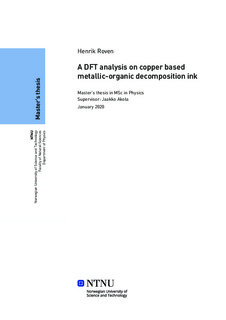En DFT analyse på kobber basert metallisk-organisk dekomponerings blekk
Master thesis
Permanent lenke
http://hdl.handle.net/11250/2646815Utgivelsesdato
2020Metadata
Vis full innførselSamlinger
- Institutt for fysikk [2677]
Sammendrag
En ny generasjon av kobber basert elektronisk blekk har blitt nylig utviklet som dekomponeres til metallisk kobber under varme. Blekkene er basert på kobber format komplekser i en +2 oksidasjonstall, som reduseres til en mellomliggende +1 oksidasjonstilstand, før den endelig dekomponeres til metallisk kobber. Nylig ble det vist at dekomponeringstemperaturen av kobber komplekset er korrelert til molekylær strukturen av begge oksidasjonstilstandene og stabiliteten av den mellomliggende oksidasjonstilstanden. Det har derfor blitt brukt tetthetsfunksjonal teori for å studere strukturen og oksidasjonen til tre kobber komplekser i både gas fase og som krystallinsk materiale. Styrken på kobber format bindingen ble undersøkt under tøyning, og samtidig overvåket oksidasjonstilstanden med DDEC6 atomistisk populasjons analyse. Trenden som ble observert var at komplekser med en sterk binding hadde høyere reduseringstemperatur. Videre blir det presentert infrarød spektrum av krystallstrukturene Cu[HCOO]2, Cu(C2H4(NH2)2[HCOO]2 and Cu(C5H5N)[HCOO]2. I tillegg ble molekylærdynamikk brukt på krystallet Cu[HCOO]2 ved konstante temperaturer, partikkel antall og volum. Tetthetsfunksjonals teorien og molekylærdynamikken ble gjort med exchange-correlation funksjonalen PBE. A new generation of copper based electronic inks have recently emerged that decomposes to metallic copper under thermal heating. The inks are based on copper formate complexes in a +2 oxidation state, whereupon heating reduces to an intermediate +1 oxidation state, before finally decomposing to metallic copper. Recently it was shown that the decomposition temperature of the copper complex is correlated to the molecular structure of both the oxidation states and the stability of the intermediate structure. To that end, density functional theory has been used to investigate the structure and oxidation of three copper complexes in both the gas phase and as crystalline solid. The strength of the copper formate bond was investigated under stretching, while continuously monitoring the oxidation state with the DDEC6 atomic population analysis. The trend observed was that the complex with stronger bond had the higher reduction temperature. Furthermore, calculated infrared spectra of the crystal structures Cu[HCOO]2 and Cu(C5H5N)[HCOO]2 are reported. In addition molecular dynamics have been performed on the crystal Cu[HCOO]2 where the temperature, particle number and volume where constrained. The density functional theory and molecular dynamics calculations are done with the exchange correlation functional PBE.
